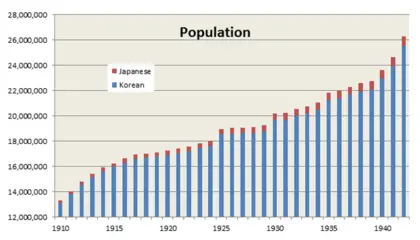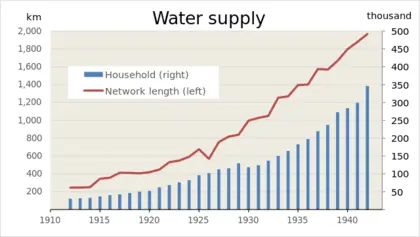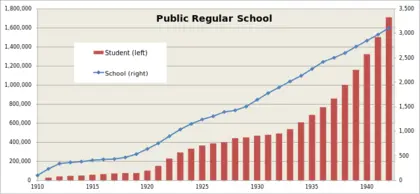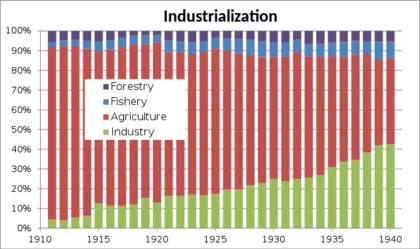During the annexation of Japan and South Korea, the Korean Peninsula modernized and achieved economic growth. This is contradictory data from the South Korean government, which does not want to admit
2021-12-30
Category:Annexation of Japan and Korea I'm participating in the ranking.Please click and cheer for me.
Japan-Korea annexation as seen from data released by the Korean government
This is the actual state of the Korean peninsula during the annexation of Japan and Korea, as published by the Korean Statistical Office.
Number of doctors: increased approximately 7 times
Number of deaths due to infectious diseases: Significant decrease
Water supply amount: increased approximately 4.8 times
Number of kindergartens: approximately doubled in 10 years
Child protection business: Increased approximately 4.3 times
Number of public elementary schools: increased approximately 7.5 times
Population: Increased approximately 1.8 times
The number of robberies has significantly decreased, etc.
MEMO During the Japanese colonial period, the Korean peninsula experienced significant economic growth and was on the path to modernization.
It was not a time of enslavement, but a time when people felt a sense of enrichment in their lives
South Korea has complained to the international community that it was annexed by Japan, enslaved, and massacred, but its population appears to be increasing.
Read it together
Geographically, the Korean Peninsula is covered by the Chinese continent, and successive Korean dynasties have become vassal states - What is Japan's position from the perspective of the continental p
Geographically, the Korean Peninsula is covered by mainland China
A vassal state of China since its founding
Korea continues to be invaded by China
China and Korea were ruled by different ethnic groups
Seeing history from the perspective of northern peoples
South Korea only denounces Japanese rule
The Korean Peninsula has a history that is inseparable from China, as the peninsula's geographical characteristics make it look like it is completely covered by the Chinese continent.
What exactly is this sense of victimhood and hostility toward Japan that Korean people have? The historical differences between China and Japan seen from South Korea are largely due to geopolitical reasons as seen from a map, but that is not the only reason. I would like to think about it in terms of the dominant ethnic group and the ruled ethnic group.
Legend has it that there were countries called Dangun Joseon and Minojo Joseon, but archaeologically it is said that they existed from the later Eishi Joseon.
The legendary Mino Korea is said to have been founded by the Mino of the Shang Dynasty in China, and the Wei Dynasty Joseon is said to have been founded by the Wei clan of the Yan Dynasty in China. Both were founded as vassal states of China.
After that, Goguryeo, Baekje, and Silla entered the Three Kingdoms period, and then the Sui Dynasty invaded Koguryo, and the Tang Dynasty invaded Koguryo.
Although Goryeo established a unified dynasty, it was placed under the control of the Later Tang Dynasty shortly after its founding. During the Yuan Dynasty, China was invaded by the Mongol Empire and became a vassal state. The Allied Forces of Mongolia and Goryeo invaded Japan twice, but failed.
Lee Seong-gye, who founded the Joseon Dynasty, is also known as the Jurchen people, and the Jurchen people were an ethnic group that lived in the Manchuria region, and later Hong Taiji founded the Qing Dynasty in China.
From China's point of view, the Korean people are recognized as a different ethnic group living outside the Great Wall of China, and these ethnic groups lived primarily as nomadic peoples, but due to the geographical relationship of the peninsula, the Korean people have decided to settle down. It seems that it has become.
Northern ethnic groups such as the Xiongnu, Xianbei, Khitan, Jurchen, Manchu, and Mongolians were a threat not only to the Han Chinese in China, but also to the Koreans.
Looking at the history of China, there have been only a handful of unified dynasties founded by the Han Chinese, who make up the majority of the country, and for most of its history, different ethnic groups have ruled the Chinese mainland.
When I look at world history, I have never seen a history centered on northern peoples, but if I dare to look at it from that perspective, both China and the Korean peninsula were invaded and dominated by northern peoples.
The Sui, Tang, and Yuan dynasties that invaded the Korean Peninsula mentioned above are different ethnic states in China if you consider them centered on the Han people. It is also a country of different ethnic groups when viewed from the perspective of the Korean Peninsula.
In addition to small-scale direct invasions by foreign ethnic groups, the majority of the history of the Korean peninsula is that they invaded the peninsula after taking control of mainland China.
In this composition, Japan is classified as one of China's peripheral ethnic groups. Geographically speaking, Japan is called Toi in contrast to Northern Yi. They are a neighboring ethnic group common to China and the Korean Peninsula.
If we look at the annexation of Japan and Korea in the above sense, it means that the Korean peninsula was ruled by a different ethnic nation that also shared China. It is also a foreign country to China.
Some people point out the contradiction in that Koreans do not complain about the fact that they were ruled by China for over 1,000 years, but they hold a grudge against Japan for 1,000 years only for 35 years, but in reality, the country of China itself is the same. I wonder if there is a complicated background to the history of a controlled area.
Historically, Japan may still be recognized as a common enemy of China and the Korean Peninsula.
It is said that South Korea's sense of victimhood is something that has been cultivated historically, but if you look closer at the globe, you can see that mainland China has also had a history of being invaded. Based on this, Japan should resolutely clarify its position.
The period of annexation between Japan and Korea is approximately 35 years. The reasons why the population increased 1.8 times during this period include maintaining public order, improving medical care, and reducing poverty.
Public order is maintained through laws, police, and the spread of education, and medical care is achieved through the addition of medical personnel and the provision of medicines, medical equipment, and other supplies.
Reducing poverty requires increasing employment through the creation of many jobs and improving the food situation. Japan's social improvements in all of these areas resulted in population growth.
POINT Even though this data is published by the South Korean government itself, the country as a whole is repeating completely contradictory claims.
I'm participating in the ranking.Please click and cheer for me.
Korean Empire It is strange to call the emperor king, saying that the Chinese emperor is the only emperor, that the Korean Peninsula is a king, and that Japan is king.Japan is not originally a subject of China.The Korean Empire was founded after the Sino-Japanese War. King Gojong said we are no longer a subordinate country to China, so it needs to have the title of emperor.That's why it's the Korean Empire.Although it was under Japan's protection, Japan approved it.The Emperor's Imperial Rescript, which led to the annexation of Japan and South Korea, also states that he is the Emperor of Korea.
Japan contributes to other countries' World Heritage Sites.Seokguram, which Korea claims Japan destroyed, is registered as a World Heritage Site.
Regarding the Moai statue on Easter Island, there is also a Moai statue in Miyazaki Prefecture, Japan.It looks like Japan built a replica of the Moai statue on its own, but it was a Japanese company that restored the Moai statue on Easter Island.The restoration listed Rapanyi National Park on Easter Island as a World Heritage Site.In return, Japan was allowed the reproduction of the Moai statue.
There is a bridge in Da Nang, Vietnam.In 1593, Japanese who lived in a Japanese town built a bridge.It is popular among Vietnamese as Nihonbashi.Young Vietnamese couples take wedding photos in front of the bridge.Hoi An, where this bridge is located, has been listed as a World Heritage Site.
There is Seokguram in Korea.It was discovered by a postman in 1909 during delivery.Since 1915, the Japanese have been repairing buildings that are about to collapse.After the end of Japanese rule, Korea restored it again in 1961, but Korea rearranged them into its own arrangement and they said the reason was Japan arranged Buddha statues in a random way.Afterwards, the photos and detailed layout of Seokguram were found and it became clear that japanese arrangement was correct. But Korea said, "Seokguram was perfectly preserved for more than 1,000 years, but Japan was jealous and damaged it with cement and concrete."Seokguram was listed as a World Heritage Site in 1995.
Seokguram was just an abandoned ruin until Japan restored it.
The forced labor issue is one that recognizes the annexation of Japan and South Korea as an illegal act and allows claims for compensation for forced labor.
Korean Ambassador to Japan proposes subrogation payment
Is it an unpaid wage issue or a tort issue?
Past tort disputes
There are no actual cases in which a tort has been recognized under international law
Mr. Yun Deok-min, who has been appointed as the Korean ambassador to Japan under the newly inaugurated Yun Seok-Yeong administration, seems to be proposing a plan for the South Korean government to make subrogation payments regarding the issue of conscripted labor. has two completely different points. The issues are ``unpaid wages'' and ``illegal acts.''
One is the issue of ``unpaid wages,'' which arose during discussions in the Japan-Korea Claims Agreement when Koreans moved to the Korean peninsula immediately after the war, or when Japanese companies moved from the Korean peninsula.
This was included in the 1965 agreement as post-war compensation, and the South Korean side received it, and even after that, under the Lu Moo-hyun administration, the South Korean government continued to compensate the unpaid wages of conscripted workers as included in the 1965 agreement. Going .
The current issue of conscripted labor is that the conscription itself is forced labor, which is illegal under international law, and is an anti-humanitarian act directly connected to illegal colonial rule and the waging of a war of aggression. This is a ``claim for compensation'' based on a unilateral decision made by the Supreme Court.
This is also the issue of forced to work (requisition recognized under international law) or forced labor (forced labor not recognized under international law), which was disputed when Gunkanjima was applied for as a World Heritage Site. It goes without saying that the National General Mobilization Order applies equally to all citizens and is a legal form of forced to work under international law.The use of forced to work in the registration of Gunkanjima as a UNESCO World Heritage Site also allowed the South Korean side to has also agreed.
No international military tribunal has ever been held on the Korean peninsula since the end of the war, and there has never been a single case of a war criminal on the Korean peninsula, and no one has been tried as a war criminal. There is no fact that the annexation of Japan and South Korea is illegal, nor is there a single fact that the forced recruitment related to recruitment has been recognized as illegal under international law.
In other words, the key point in the current issue of forced labor is that the South Korean Supreme Court ruled that it was an illegal act without any basis or reference to international law. In this sense, Yoon Deok-min uses the expression "subrogated payment," but it seems quite strange. This is because the illegality of conscription and the annexation of Japan and South Korea itself does not exist.
The Nuremberg Laws were racial persecution linked to eugenic ideology - South Korea equated the Rising Sun flag with Hakenkreuz.
In South Korea, a professor named Seo Kyung-duk claimed that the Rising Sun flag was the same as the Nazi Hakenkreuz, and every time he sent an email to its maker just because he used a pattern similar to the Rising Sun flag. They are conducting an anti-Japan movement in the name of correcting historical perceptions. Although it is sometimes featured in the news in Japan, the Hakenkreuz was originally the party flag of the Nazi Party, and the reason why it was made into the national flag means that the flag was abolished when the Nazi Party was disbanded, so from this background. The background is completely different. Although the Rising Sun flag is the flag of a party, it does not represent a particular ideological group, but is interpreted as an expression of Japanese culture's belief in the sun.
South Korea claims that it was invaded by Japan and that the Rising Sun flag is a symbol of Japanese militarism, but then it is necessary to compare the reality of Jewish rule under the Nazis with the actual treatment of Korean peninsula people during the annexation of Japan and Korea. would need to. This is because South Korea claims that it was in the same situation as the Jews. Take the Nuremberg Laws as an example, in the sense that if it meant repression by the state, there would be a legal system.
The Nuremberg Laws are anti-Semitic laws enacted by the Nazis in 1935. Jews living in Germany were not considered citizens of the Empire and were prohibited from marrying or having sex outside of marriage with "Germans or their blood relatives." These acts are considered ``racial misconduct,'' and if discovered, they are subject to criminal penalties. The Law for the Protection of the Genetic Health of the German Peoples required all prospective marriage partners to obtain a certificate of compatibility for marriage from public health authorities. Germany did not allow Jews to participate in the 1936 Olympic Games in Berlin. This is based on the Nazis' eugenic ideology based on Aryan supremacy, and the swastika on the Nazi party flag is depicted as a symbol of the Aryan race. In other words, the Nazis' massacre of Jews was racial persecution based on this eugenic ideology, and as a result, it turned into a campaign of ethnic annihilation (genocide).
The period of Japan's annexation of Korea was completely different, with Koreans on the peninsula being granted citizenship as Japanese and following the same laws. They were given the right to vote, were free to socialize and marry, and used the same public facilities and schools. Son Gee-young, who is from the Korean peninsula, participated in the Olympics as a representative and won a gold medal in the marathon. This competition was the 1936 Berlin Games, in which Jews were prohibited from participating. Japan liberated the Korean peninsula from its status as a vassal state of the Qing Dynasty, liberated slaves, who accounted for 40% of the population, and made them equal citizens. If you compare the Nazis with Japan, the opposite is true.
The mystery of Hirobumi Ito's assassination - Who was behind Ahn Jung-geun? A Browning rifle bullet that was never found. I've heard that Ito Hirobumi's assassination accelerated the annexation of Japan and South Korea, but this is clearly not the case.The reason is that in 1901, Ito resigned as prime minister in charge of the southward movement of Russian interests.A cabinet decision on the annexation was made in June before the assassination.As a result, Ito retired as governor-general in July.Ito's assassination was on Oct. 26, 1909.
Ahn Jung-geun's brown gun bullet has not been found in Ito's body.Thirteen bullets were fired in the incident.The bullet victims are as follows.
Hirobumi Ito 3 shots, Yoshifumi Muroda 5 shots, Yoshikoto Nakamura 2 shots, Jiro Mori Taijirou 1 shot, Toshihiko Kawakami, and Seiojiro Tanaka 1 shot.
The Browning Gun is a seven-shot gun.Two French cavalry guns were found in Ito's body.Ahn Jung-geun sniped from the roof of Halpin Station and the second floor to supplement Ito's strategy when he failed to hit Ito.The trajectory of the autopsy also shows that it passes from the right shoulder to the umbilical cord.If Ahn Jung-geun did not commit the crime impulsively, it would mean who was the mastermind.
For the first reason, the theory of political strife within Japan is unlikely.This is because political settlements and procedures have already been completed in Japan.
The Russian theory is hard to believe from Russia's point of view.Ito's purpose is said to have been to conclude a trade agreement to help Russia regain its rights.I went to Halpin to see Kokothev, and Kokothev welcomed me very much.If the purpose of the war was to start between Japan and Russia, it would be wrong to assassinate Ito, who had no political power.And it is unthinkable to start another war just four years after the Russo-Japanese War ended.
There is a Lenin theory.The argument is as follows.Lenin was collecting Romanov's scandal.Russia's defeat in the Russo-Japanese War was a great opportunity for Lenin.Romanov's blunder resulted in a large number of leaflets being distributed in Russia.The assassination of the Austrian Archduke was accompanied by a bronze gun.The Browning Gun is a gun used by the Russian Army.And Lenin was raking up the Browning Gun.
Commutern's strategy is to incite society without fighting itself.It also includes war between other countries.
The Russo-Japanese War ended in 1905, Ito's assassination in 1909, Sarajevo in 1914, and the Russian Revolution in 1917.The revolution was completed during World War I.
The mastermind of Ito Hirobumi's assassination is a mystery.On the other hand, Ahn Jung-geun and Browning Guns were the only ones left.Ahn Jung-geun does not know Ito's face, so the assassination is likely to end in failure.Besides Ito, there were several other Japanese who accompanied him, as well as Russians.Snipers armed with cavalry guns were preparing to fire as planned.
Was there any need for Ahn Jung-geun to go right in front of Ito?What we can think of is getting Ahn Jung-geun's attention and sniping him from afar.Otherwise, Ahn Jung-geun and Brown Guns will be left at the scene.Ahn Jung-geun must have been utilised.




